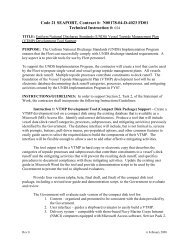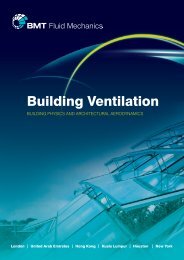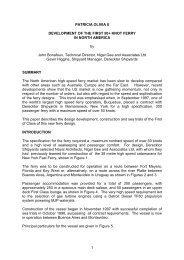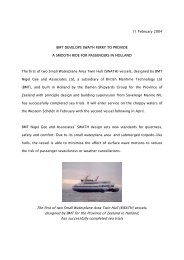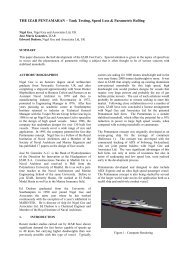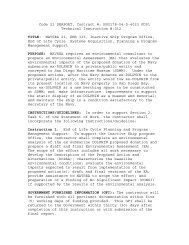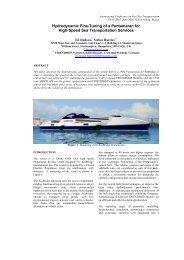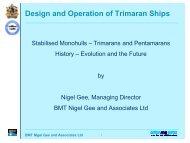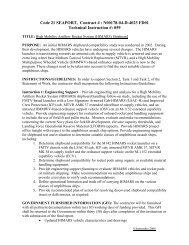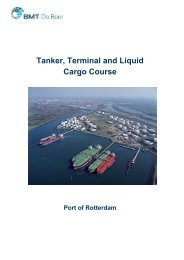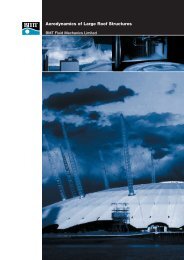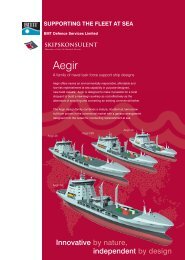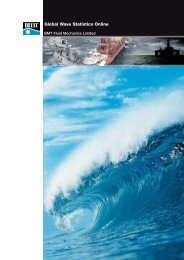Future Ship Concepts for Repair and Maintenance at Sea
Future Ship Concepts for Repair and Maintenance at Sea
Future Ship Concepts for Repair and Maintenance at Sea
Create successful ePaper yourself
Turn your PDF publications into a flip-book with our unique Google optimized e-Paper software.
Paper on <strong>Future</strong> <strong>Ship</strong> <strong>Concepts</strong> <strong>for</strong> <strong>Repair</strong> <strong>and</strong> <strong>Maintenance</strong> <strong>at</strong> <strong>Sea</strong>, Presented <strong>at</strong> World MaritimeTechnology Conference - in London, UK<strong>Future</strong> <strong>Ship</strong> <strong>Concepts</strong> <strong>for</strong> <strong>Repair</strong> <strong>and</strong><strong>Maintenance</strong> <strong>at</strong> <strong>Sea</strong>Andy Kimber, BEng, CEng, MRINABMT Defence Services Limited, UKSYNOPSISThe repair <strong>and</strong> maintenance of naval vessels deployed away from their primary support infrastructure isan often overlooked area, with existing repair <strong>and</strong> maintenance ships either being of old design orvessels converted from commercial ships. Increasingly the n<strong>at</strong>ure of the Royal Navy <strong>and</strong> other navyoper<strong>at</strong>ions will see an emphasis on deployments away from home w<strong>at</strong>ers <strong>for</strong> extended periods as globalpresence is dem<strong>and</strong>ed from a decreasing pool of warships. Hence the maintenance <strong>and</strong> repair ofdeployed naval vessels will become a significant issue. Additionally, future changes in the oper<strong>at</strong>ingn<strong>at</strong>ure of the fleet with an increased focus in support of expeditionary warfare <strong>and</strong> humanitarian reliefoper<strong>at</strong>ions will require more utilitarian vessels.The impact of these evolving oper<strong>at</strong>ions on potential concepts <strong>for</strong> future maintenance vessels has beenexplored <strong>and</strong> notional requirements developed. These have been considered against a variety of vesseloptions <strong>and</strong> an innov<strong>at</strong>ive heavy lift ship solution has been developed as one potential concept <strong>for</strong> anexpeditionary repair <strong>and</strong> maintenance pl<strong>at</strong><strong>for</strong>m.This paper explores some of the potential future requirements <strong>for</strong> the next gener<strong>at</strong>ion of repair <strong>and</strong>maintenance vessels, within a historical context of current <strong>and</strong> past vessels. Two case studies arepresented <strong>and</strong> discussed <strong>for</strong> a cable ship conversion <strong>and</strong> an innov<strong>at</strong>ive heavy lift concept as potentialsolutions.Author’s BiographyAndy Kimber is a Managing Naval Architect <strong>at</strong> BMT Defence Services Limited, where he leads the Naval Architecture<strong>Future</strong> Pl<strong>at</strong><strong>for</strong>ms Team. He has undertaken a variety of future ship <strong>and</strong> options studies over the past three years.Previous to this role, he held the position of Pl<strong>at</strong><strong>for</strong>m Architecture Manager <strong>for</strong> the Thales CVF team <strong>for</strong> three years.Andy has a wide experience of design, in service support <strong>and</strong> disposal activities since joining BMT Defence Services in1990, after completing a degree in Naval Architecture <strong>and</strong> Ocean Engineering <strong>at</strong> University College, London between1986 <strong>and</strong> 1989.HISTORISICAL PERSPECTIVEThe repair ship, depot ship or maintenance ship is somewh<strong>at</strong> of a Cinderella capability; <strong>for</strong> much of thetime the vessels quietly support their navies in overseas deployments <strong>and</strong> are often overlooked. However,occasionally these vessels are seen in the public eye when their capability proves invaluable to anoper<strong>at</strong>ion.This was seen in the recent comments following Oper<strong>at</strong>ion Telic in which RFA DILIGENCE was singledout by Admiral Sir Alan West; “The basic repair ship was invaluable during Telic”, Reference [1]. Thesame vessel again proved her worth in 2005 when she provided support to civilian authorities in theafterm<strong>at</strong>h of the Tsunami.For the purposes of this paper, the three types relevant to the discussions are:<strong>Repair</strong> vessels - extensive workshops <strong>and</strong> facilities to repair damaged ships;March 2006 Page 1 of 11 © BMT DEFENCE SERVICES LTD
Paper on <strong>Future</strong> <strong>Ship</strong> <strong>Concepts</strong> <strong>for</strong> <strong>Repair</strong> <strong>and</strong> <strong>Maintenance</strong> <strong>at</strong> <strong>Sea</strong>, Presented <strong>at</strong> World MaritimeTechnology Conference - in London, UKDepot vessels - provide administr<strong>at</strong>ive, recre<strong>at</strong>ional, provision <strong>and</strong> maintenance support, notablyto submarines, destroyers <strong>and</strong> smaller strike craft which require significant external support<strong>Maintenance</strong> <strong>Ship</strong>s - provide more limited workshops <strong>and</strong> smaller staff <strong>for</strong> the less dem<strong>and</strong>ingsupport of vessels other than damage repair.An early example is the Torpedo Bo<strong>at</strong> Depot ship HMS VULCAN. This purpose built vessel, launched13th June 1889, was designed to oper<strong>at</strong>e as a “mothership” to the smaller torpedo bo<strong>at</strong> craft, which shecarried <strong>and</strong> deployed by large cranes. Extensive workshops <strong>and</strong> repair facilities allowed her to support notonly the torpedo bo<strong>at</strong>s but to per<strong>for</strong>m a wider repair ship role to the fleet. L<strong>at</strong>er used as a submarine depotship, she survived until she was scrapped in 1955.Fig 1 - Torpedo bo<strong>at</strong> Depot <strong>and</strong> Mothership HMSVULCANFig 2 - Workshops aboard HMS VULCANTo demonstr<strong>at</strong>e the width of activities being conducted, by the end of the second world war the Royal Navyoper<strong>at</strong>ed a significant number of vessels offering support to ships <strong>at</strong> sea, often optimised <strong>for</strong> a specific role<strong>and</strong> not always fully able to meet the dem<strong>and</strong>s.Table I Wartime Depot <strong>and</strong> <strong>Repair</strong> <strong>Ship</strong>sConversionsPurpose BuiltSubmarine Depot <strong>Ship</strong>s 10 5Destroyer / Escort Depot <strong>Ship</strong>s 4 5<strong>Repair</strong> ships 11 5 1Costal Forces, L<strong>and</strong>ing Craft <strong>and</strong> Auxiliary Vessel Depot <strong>Ship</strong>s 17 6<strong>Maintenance</strong> <strong>and</strong> <strong>Repair</strong> <strong>Ship</strong>s 14 + 5 2Aircraft <strong>Maintenance</strong> <strong>and</strong> <strong>Repair</strong> <strong>Ship</strong>s 1 31Vessels transfer from USN under lend / lease arrangements2Vessels completed as merchant hulls post warBy the 1970’s, the number of vessels in UK service had reduced to small number of depot ships (submarine<strong>and</strong> destroyers) <strong>and</strong> one heavy repair vessel. These included the dedic<strong>at</strong>ed submarine depot vessels HM<strong>Ship</strong>s FORTH, MAIDSTONE <strong>and</strong> TYNE <strong>and</strong> the heavy repair ship HMS TRIUMPH.The depot vessels were purpose built, d<strong>at</strong>ing from the 1930’s, <strong>and</strong> were l<strong>at</strong>terly used to provide support tothe UK nuclear submarine fleet whilst dedic<strong>at</strong>ed shore facilities were constructed. On their completion, thesubmarine depot ships were no longer required <strong>and</strong> the move to an all nuclear fleet only oper<strong>at</strong>ing out ofthe dedic<strong>at</strong>ed naval bases neg<strong>at</strong>ed their need in the fleet.The heavy repair vessel HMS TRIUMPH was converted from an aircraft carrier in 1958 to 1965 withextensive workshops in the <strong>for</strong>mer hangar <strong>and</strong> deckhouses constructed on the <strong>for</strong>mer flight deck. A notablefe<strong>at</strong>ure was th<strong>at</strong> the repair facilities were kept in mothballs in peacetime <strong>and</strong> the vessel primarily used <strong>for</strong>maintenance of vessels deployed to the Far East.March 2006 Page 2 of 11 © BMT DEFENCE SERVICES LTD
Paper on <strong>Future</strong> <strong>Ship</strong> <strong>Concepts</strong> <strong>for</strong> <strong>Repair</strong> <strong>and</strong> <strong>Maintenance</strong> <strong>at</strong> <strong>Sea</strong>, Presented <strong>at</strong> World MaritimeTechnology Conference - in London, UKFig 3 - Heavy <strong>Repair</strong> <strong>Ship</strong> HMS TRIUMPHFig 4 - Submarine Depot <strong>Ship</strong> HMS TYNEThese vessels steadily paid-off as global deployments reduced <strong>and</strong> newer shore facilities were developed tosupport the warships; the final repair ship HMS TRUIMPH also paid off in 1975 without replacement,finally being broken up in 1981.By the time of the Falkl<strong>and</strong>s Conflict, no dedic<strong>at</strong>ed repair vessel remained in service. Given the extremedistance of the oper<strong>at</strong>ions from the UK <strong>and</strong> the lack of host n<strong>at</strong>ion support close to the the<strong>at</strong>re ofoper<strong>at</strong>ions, very quickly the need to covert a commercial vessel <strong>for</strong> service as a repair ship was identified.The offshore support vessel M/V STENA INSPECTOR was taken up <strong>for</strong> service <strong>and</strong> quickly modified.The vessel was such a success th<strong>at</strong> she was purchased <strong>and</strong> <strong>for</strong>mally converted to a Forward <strong>Repair</strong> ship,entering service in 1984 as RFA DILIGENCE. Built in 1981, be<strong>for</strong>e being taken up from trade in 1982 <strong>and</strong>purchased outright by the MoD 1983, the vessel was converted <strong>at</strong> a cost of £25M to dedic<strong>at</strong>ed <strong>for</strong>wardrepair ship. This vessel is expected to remain in service beyond the end of this decade, Reference [2].Today, RFA DILIGENCE acts not only as a <strong>for</strong>ward repair vessel, but as a maintenance vessel <strong>and</strong>occasionally as an MCM support vessel. She has been supplemented by deployment of temporary modules<strong>for</strong> MCM vessel support, notably on survey vessels <strong>and</strong> more recently LSL’s vessels.Fig 5 - Forward <strong>Repair</strong> <strong>Ship</strong> RFA DILIGENCEOverall, it can be seen th<strong>at</strong> even in the most recent oper<strong>at</strong>ions, the repair <strong>and</strong> maintenance ship remains animportant element of the globally deployable navy, although the number of hulls has dram<strong>at</strong>ically reducedto today when only one dedic<strong>at</strong>ed pl<strong>at</strong><strong>for</strong>m is in use by the UK.PAST AND CURRENT CAPABILITIESA paper presented to the Royal Institute of Naval Architects in 1947, Reference [3], provides a detailedaccount of the modific<strong>at</strong>ions <strong>and</strong> success of the wartime repair <strong>and</strong> depot ships <strong>and</strong> compares theconversion of mercantile vessels to the dedic<strong>at</strong>ed builds.The key characteristics <strong>and</strong> lessons learnt <strong>for</strong> the immedi<strong>at</strong>e post war vessels were:March 2006 Page 3 of 11 © BMT DEFENCE SERVICES LTD
Paper on <strong>Future</strong> <strong>Ship</strong> <strong>Concepts</strong> <strong>for</strong> <strong>Repair</strong> <strong>and</strong> <strong>Maintenance</strong> <strong>at</strong> <strong>Sea</strong>, Presented <strong>at</strong> World MaritimeTechnology Conference - in London, UKDISCUSSION ON FUTURE REQUIREMENTSWith many of the in-service vessels nearing the end of their useful lives, the issue of replacement needs tobe considered. However, in budget constrained times these ships are increasingly “unaf<strong>for</strong>dable” but evermore necessary.The <strong>Future</strong> Navy paper, Reference [4] rein<strong>for</strong>ces concepts of global reach with sustainability <strong>and</strong>,importantly, decreasing the Joint Force dependence on Host N<strong>at</strong>ion Support (HNS). This leads to the need<strong>for</strong> vessels to provide a wide range of support to both the fleet <strong>and</strong> expeditionary <strong>for</strong>ces ashore.The primary role of the vessel is likely to remain as today, i.e. the need to provide equipment support <strong>and</strong>repair. Specifically:To provide a maintenance capability to allow ships to remain in the<strong>at</strong>re <strong>for</strong> extended periods withless reliance on HNS;To provide an unplanned maintenance capability to vessels <strong>and</strong> equipment to allow them to remainon st<strong>at</strong>ion;To repair damaged asset (from get-home capability to salvage).Whilst this implies th<strong>at</strong> many of the facilities seen in today’s maintenance <strong>and</strong> repairs ships will remain inthe next gener<strong>at</strong>ion, there are some changes th<strong>at</strong> are likely to occur. These include the increased use ofcomposite m<strong>at</strong>erials requiring large composite workshop <strong>and</strong> the increased use of modular replacementr<strong>at</strong>her than repair of components. The l<strong>at</strong>ter will reduce the need <strong>for</strong> repair onboard but will increase thestores required <strong>and</strong> will also require enhanced communic<strong>at</strong>ions <strong>and</strong> transport facilities to allow assetordering, tracking <strong>and</strong> transport.Increased submarine support may also emerge as a new requirement in the next gener<strong>at</strong>ion vessels <strong>for</strong> theUK. As discussed earlier, the Submarine Depot ship was a valuable asset in the time of the short rangeconventional submarine, but has disappeared as nuclear powered submarines became common <strong>for</strong> themajor navies. However, the renewed emphasis on global reach, sustained oper<strong>at</strong>ions in support of ground<strong>for</strong>ces <strong>and</strong> power projection combined with a smaller submarine fleet suggest the ability to rearm <strong>and</strong> toprovide respite <strong>for</strong> the crews in the<strong>at</strong>re may become an important factor. Notable factors th<strong>at</strong> mayinfluence a future repair ship are:Need to assist submarines in mooring due to poor low speed manoeuvring;Primary consumables support is munitions supply, which differs from surface ship resupply;Nuclear plant imposes range of constraints.As well as providing direct support to navy vessels (maintenance <strong>and</strong> required repair), the future repair <strong>and</strong>maintenance vessel will increasingly be used to support non-naval elements. The maintenance ofhelicopters may be achieved more efficiently on board vessels than ashore, due to the presence of dedic<strong>at</strong>edfacilities <strong>and</strong> a more controlled <strong>at</strong>mosphere. Whilst a number of support ships offer exp<strong>and</strong>ed avi<strong>at</strong>ionmaintenance facilities, the repair ship could offer much deeper levels of maintenance <strong>and</strong> repair due to thegre<strong>at</strong>er available workshop area <strong>and</strong> heavier machinery.Also humanitarian <strong>and</strong> disaster relief will be seen as an important future role, emphasising the non-militaryutility of such vessels. This is unlikely to be af<strong>for</strong>dable if expect<strong>at</strong>ions are high, but the incorpor<strong>at</strong>ion offacilities <strong>at</strong> small cost should be considered.A vessel incorpor<strong>at</strong>ing all the above capabilities <strong>and</strong> flexibility will clearly become an important part of theemerging global sustainability requirement <strong>and</strong> emerging sea-basing requirements. However, the potential<strong>for</strong> dedic<strong>at</strong>ed <strong>and</strong> specialised vessels is unlikely <strong>and</strong> a single vessel with all these <strong>at</strong>tributes may be difficultto design <strong>and</strong> ultim<strong>at</strong>ely unaf<strong>for</strong>dable.March 2006 Page 5 of 11 © BMT DEFENCE SERVICES LTD
Paper on <strong>Future</strong> <strong>Ship</strong> <strong>Concepts</strong> <strong>for</strong> <strong>Repair</strong> <strong>and</strong> <strong>Maintenance</strong> <strong>at</strong> <strong>Sea</strong>, Presented <strong>at</strong> World MaritimeTechnology Conference - in London, UKPOTENTIAL SOLUTIONSThere are a variety of options open to provide the future repair vessel <strong>and</strong> the principal options wouldinclude:A modular facility th<strong>at</strong> may be temporarily hosted on an existing vessel;A conversion of an existing vessel (probably commercial vessel);A barge facility th<strong>at</strong> may be moved by a heavy lift vessel;A purpose designed vessel.This paper addresses some of the issues <strong>and</strong> potential concepts th<strong>at</strong> emerge from the first three options.The Modular FacilityThe modular approach to maintenance facilities offers the advantages of flexibility in the capability to bedeployed <strong>and</strong> may be hosted on various non-specialised vessels.Modular support facilities have been in use <strong>for</strong> a long time in roles such as the RN MCM Support Unit.Using st<strong>and</strong>ard ISO containers, the support workshops <strong>and</strong> stores have been embarked in a number ofvessels, such as RFA SIR GALAHAD. These facilities allow <strong>for</strong>ward deployment of MCM vessels whichare too small to deploy overseas without external support.It is easy to consider the expansion of this capability to provide support to a wider fleet. The use ofcontainers would allow selective deployment of facilities according to the vessels to be supported <strong>and</strong> themission being supported. A dedic<strong>at</strong>ed pl<strong>at</strong><strong>for</strong>m is not required <strong>and</strong> the containers are even l<strong>and</strong> deployableif necessary.However, a purely modular approach has some significant drawbacks:Cranage has to be available on the host vessel;Large area workshops cannot be provided;To provide the range of systems/workshops <strong>for</strong> deeper maintenance, a large number of containersare required;Sufficient accommod<strong>at</strong>ion has to be available on the host vessel <strong>for</strong> the maintenance / repair staff.These factors suggest th<strong>at</strong> the modular approach is well suited to a maintenance role <strong>and</strong> supportingspecific vessel types. It is however difficult to provide the required facilities only in this way <strong>for</strong> very deepmaintenance <strong>and</strong> ship repair.The Commercial ConversionCommercial conversions have always been used to provide repair <strong>and</strong> maintenance vessels. Historicallyvessels were mostly adapted from liners <strong>and</strong> passenger ships. More recently, offshore vessels have beenused, notably RFA DILIGENCE <strong>and</strong> <strong>for</strong> a short period her “sister” M/V STENA SEASPREAD. Warshipconversions also have fe<strong>at</strong>ured in the past, notably HMS TRUIMPH as already discussed, but also the<strong>for</strong>mer Italian frig<strong>at</strong>e ALPINO converted to an MCM comm<strong>and</strong> <strong>and</strong> support ship <strong>and</strong> the <strong>for</strong>mer Swedishminelayer HMS ALVSBORG now in service with the Chilean navy as a submarine <strong>and</strong> fast <strong>at</strong>tack craftdepot vessel.March 2006 Page 6 of 11 © BMT DEFENCE SERVICES LTD
56 57 58 a b c d e f g h i j k l m n o 59Paper on <strong>Future</strong> <strong>Ship</strong> <strong>Concepts</strong> <strong>for</strong> <strong>Repair</strong> <strong>and</strong> <strong>Maintenance</strong> <strong>at</strong> <strong>Sea</strong>, Presented <strong>at</strong> World MaritimeTechnology Conference - in London, UKTable III presents a comparison of current commercial vessel types against the repair <strong>and</strong> maintenance shiprole.Table III Comparison of Commercial <strong>Ship</strong> Advantages / DisadvantagesOffshore Support Cruise ship, liner Containership RO-RO Cable shipVesselSpace <strong>for</strong> Workshops Adequ<strong>at</strong>e Limited Good Good Very GoodAccommod<strong>at</strong>ion Limited Good Very Limited Possibly LimitedDynamic positioning Yes No No No YesSpeed Adequ<strong>at</strong>e Good Good Good Adequ<strong>at</strong>eCranage Yes No Possibly No YesSpace <strong>for</strong> AuxiliarySystemsLimited Limited Good Good GoodThe cable ship offers an interesting proposition <strong>for</strong> conversion due to its basic configur<strong>at</strong>ion. Key fe<strong>at</strong>uresinclude a large working deck, often covered with rear access <strong>and</strong> large cable holds which may be utilised<strong>for</strong> holds <strong>and</strong> additional machinery <strong>and</strong> accommod<strong>at</strong>ion. A principal disadvantage is the lack of berths <strong>for</strong>the naval repair party.Fig 6 indic<strong>at</strong>es the concept of conversion <strong>for</strong> the (<strong>for</strong>mer) James Fisher vessel C/S OCEANIC PEARL.The extensive workshop facilities would be arranged within the cable deck, which is already served by anoverhead gantry <strong>for</strong> movement of heavy items <strong>and</strong> pl<strong>at</strong>e. Existing electronics support spaces <strong>and</strong> testequipment spaces would serve as clean workshops. The cable deck accesses the stern working area througha large, hydraulically oper<strong>at</strong>ed door, which would provide the primary transit route <strong>for</strong> equipments beingshipped from the vessel(s) alongside.The current working deck includes a large A frame <strong>for</strong> the deployment of the cable plough. This would beremoved <strong>and</strong> the area cleared of obstructions to provide a working space <strong>for</strong> large items such as dieselgener<strong>at</strong>ors to be shipped <strong>and</strong> maintained. The working deck <strong>and</strong> the upper we<strong>at</strong>her deck would providecontainer stowages <strong>for</strong> specialised modular workshops <strong>and</strong> additional stores.Fig 6 C/S OCEANIC PEARL Proposed Conversion as <strong>Repair</strong> <strong>Ship</strong>The vessel’s hull is domin<strong>at</strong>ed by the large cable holds, extending over one-third of the length of the vessel.During the conversion, the holds would be removed <strong>and</strong> the space subdivided by additional transversew<strong>at</strong>ertight bulkheads to improve stability <strong>and</strong> provide additional compartment<strong>at</strong>ion. The <strong>for</strong>ward parts ofthe <strong>for</strong>mer hold would provide additional accommod<strong>at</strong>ion <strong>for</strong> the naval party; the existing accommod<strong>at</strong>ionis suitable <strong>for</strong> the RFA complement plus senior embarked repair staff, with an approxim<strong>at</strong>ely 100 berthsadded in the conversion.March 2006 Page 7 of 11 © BMT DEFENCE SERVICES LTD
Paper on <strong>Future</strong> <strong>Ship</strong> <strong>Concepts</strong> <strong>for</strong> <strong>Repair</strong> <strong>and</strong> <strong>Maintenance</strong> <strong>at</strong> <strong>Sea</strong>, Presented <strong>at</strong> World MaritimeTechnology Conference - in London, UKOne space below the cable deck would be utilised as an additional auxiliary machinery compartment. Thenew auxiliaries would be required to support the additional hotel loads associ<strong>at</strong>ed with the newaccommod<strong>at</strong>ion complex <strong>and</strong> the workshop equipments. In addition, overboard supplies of power, w<strong>at</strong>er,air <strong>and</strong> fuel are proposed. The current vessel is diesel electric with three diesel gener<strong>at</strong>ors providing thepropulsive <strong>and</strong> power loads. This offers a high degree of flexibility in power management, as the vesselwould not be underway when conducting repairs or maintenance <strong>and</strong> hence an excess of power would beavailable. However, all the diesel gener<strong>at</strong>or sets are currently loc<strong>at</strong>ed aft in one space, there<strong>for</strong>e to improveredundancy of supply, additional diesel gener<strong>at</strong>or sets (two <strong>at</strong> 1MW) are proposed as the primary overboardsupply sets. These would be cross connected to the current power systems, but would also be able tooper<strong>at</strong>e independently if required.The remaining hold space would provide large cargo holds <strong>for</strong> the spares <strong>and</strong> tools, with exp<strong>and</strong>ed deepdouble bottom tankage provided <strong>for</strong> additional fuel <strong>and</strong> fresh w<strong>at</strong>er.The vessel is already equipped with a single container h<strong>and</strong>ling crane; this would be supplemented byadditional cranage serving the aft working area <strong>and</strong> small cranes serving the flight deck which had beenloc<strong>at</strong>ed aft of the bridge. This vessel is also is also provided with a dynamic positioning <strong>and</strong> joystickcontrol <strong>for</strong> manoeuvring.The Flo<strong>at</strong> On / Flo<strong>at</strong> Off VesselA heavy lift flo<strong>at</strong> on-flo<strong>at</strong> off (Flo-Flo) concept is illustr<strong>at</strong>ed in Fig 7 <strong>and</strong> has the following advantages indelivering a repair <strong>and</strong> maintenance capability:Large open deck <strong>for</strong> flexibility in embarking different options.Low freeboard <strong>for</strong> ship <strong>and</strong> submarine access.Ability to lift a vessel out of the w<strong>at</strong>er <strong>for</strong> underw<strong>at</strong>er engineering.Ability to recover damaged vessels.It is anticip<strong>at</strong>ed th<strong>at</strong> the vessels could oper<strong>at</strong>e in three modes according to oper<strong>at</strong>ional tasking:Retain facilities onboard, oper<strong>at</strong>ing as a “conventional” repair vessel.Deliver the facilities to a sheltered area or port <strong>and</strong> then leave.Offload the facilities in sheltered area or port <strong>and</strong> remain alongside as a “flo<strong>at</strong> dock”.It may not be necessary to purchase the FLO-FLO, possibly using assured charter or PFI arrangements toprovide a guarantee of a vessel being available <strong>at</strong> short notice to embark the repair facility when required.The concept <strong>for</strong> the barge design illustr<strong>at</strong>ed in Fig 8 is based on maximum dimensions 120 metres by 32metres, consistent with a range of existing FLO/FLO vessels, <strong>and</strong> has a light displacement of approxim<strong>at</strong>ely3,500 tonnes. The basic layout is driven by the principle of separ<strong>at</strong>ing the workshops <strong>at</strong> one end <strong>and</strong> theaccommod<strong>at</strong>ion <strong>at</strong> the other. This provides separ<strong>at</strong>ion of workplace from quarters <strong>and</strong> should minimise thetransmission of noise <strong>and</strong> vibr<strong>at</strong>ion from the workshop area to the accommod<strong>at</strong>ion block. The spacebetween the workshop <strong>and</strong> accommod<strong>at</strong>ion blocks, over 60metres in length, is then available as a flexibleworking <strong>and</strong> storage area.March 2006 Page 8 of 11 © BMT DEFENCE SERVICES LTD
Paper on <strong>Future</strong> <strong>Ship</strong> <strong>Concepts</strong> <strong>for</strong> <strong>Repair</strong> <strong>and</strong> <strong>Maintenance</strong> <strong>at</strong> <strong>Sea</strong>, Presented <strong>at</strong> World MaritimeTechnology Conference - in London, UKFig 7 FLO-FLO Workshop / Accommod<strong>at</strong>ion BargeFig 8 Illustr<strong>at</strong>ive Layout of <strong>Repair</strong> BargeA large dedic<strong>at</strong>ed workshop area of 960m2 is provided on a single level <strong>at</strong> one end of the barge. This isaccessed via large doors from the working deck <strong>and</strong> is subdivided into a range of workshop types as shownin Fig 9. The principle used to develop this arrangement is to provide easy access <strong>and</strong> movement <strong>for</strong> heavyitems; all the workshops are arranged on one level <strong>and</strong> the Mechanical <strong>and</strong> Composite workshops areprovided with large openings on to the working deck to allow the movement of heavy items of equipment<strong>and</strong> structural assemblies (or indeed airframes) into the workshops. The smaller <strong>and</strong> clean workshops areprovided to the rear of the block, <strong>and</strong> if necessary can be safely accessed without access through the otherworkshops.MachineryPersonnelStructure /airframesFig 9 - Layout of WorkshopsMarch 2006 Page 9 of 11 © BMT DEFENCE SERVICES LTD
Paper on <strong>Future</strong> <strong>Ship</strong> <strong>Concepts</strong> <strong>for</strong> <strong>Repair</strong> <strong>and</strong> <strong>Maintenance</strong> <strong>at</strong> <strong>Sea</strong>, Presented <strong>at</strong> World MaritimeTechnology Conference - in London, UKThe roof area of the workshops has been reserved <strong>for</strong> a helicopter deck. A further l<strong>and</strong>ing spot may also beprovided on top of the accommod<strong>at</strong>ion block, however, to reduce noise the main oper<strong>at</strong>ing area isconsidered best placed away from accommod<strong>at</strong>ion. This oper<strong>at</strong>ing area is of sufficient size to l<strong>and</strong> anyhelicopter up to Chinook size, <strong>and</strong> there is area which may also be utilised as a vertical replenishmentstores dump or even as an avi<strong>at</strong>ion repair complex. In Fig 8 it can be seen th<strong>at</strong> a series of containerisedworkshops is illustr<strong>at</strong>ed <strong>for</strong> by-type maintenance of helicopters.The accommod<strong>at</strong>ion block assumed is a two story, modular arrangement capable of providingaccommod<strong>at</strong>ion <strong>for</strong> up to 200; this is sufficient <strong>for</strong> a very large support party <strong>and</strong> also accommod<strong>at</strong>ion <strong>for</strong>ship / submarine crews alongside if required. In this concept, the accommod<strong>at</strong>ion is not required to c<strong>at</strong>er<strong>for</strong> the ship complement as they are embarked in the heavy lift vessel.The area between the workshop <strong>and</strong> accommod<strong>at</strong>ion block would act as the main working deck. Extensivecarnage, shown in Fig 10, may be provided along each side <strong>for</strong> supporting vessels, removal <strong>and</strong>replacement of equipments as well as provided a self loading capability. To aid rapid storing <strong>and</strong> re-role ofthe facility, it is assumed th<strong>at</strong> much of the stores would be provided using st<strong>and</strong>ard sized ISO containers. Itis also possible th<strong>at</strong> additional workshops, gener<strong>at</strong>ors <strong>and</strong> other facilities may be provided as containersstored on this deck. It would be possible, <strong>for</strong> example, to provide power using containerised dieselgener<strong>at</strong>ors (<strong>for</strong> example 1 M per unit), hence allowing flexibility in the number carried <strong>and</strong> allowmaintenance by replacement. Indeed, the units may even be hired in as required by the vessel’s role <strong>and</strong>deployment p<strong>at</strong>tern.Fig 10 - Deck Arrangement of Illustr<strong>at</strong>ive <strong>Repair</strong> Barge ConceptFinally, the barge offers an extensive volume th<strong>at</strong> may be used <strong>for</strong>:Auxiliary machinery as a permanent fit;Bulk Stores;Fluid Stores;Ballast tanks to affect trim / draught when not embarked on the FLO-FLO.This would be further supplemented by the FLO-FLO vessel itself, which is capable of carrying both cargosolids <strong>and</strong> fluids to supplement its heavy lift cargos.March 2006 Page 10 of 11 © BMT DEFENCE SERVICES LTD
Paper on <strong>Future</strong> <strong>Ship</strong> <strong>Concepts</strong> <strong>for</strong> <strong>Repair</strong> <strong>and</strong> <strong>Maintenance</strong> <strong>at</strong> <strong>Sea</strong>, Presented <strong>at</strong> World MaritimeTechnology Conference - in London, UKCONCLUSIONThere is likely to be an increasing gap between the funding available <strong>and</strong> the need <strong>for</strong> this Cinderellacapability; indeed future oper<strong>at</strong>ional needs are likely to imply a much exp<strong>and</strong>ed roles <strong>for</strong> this type of vesseldue to its flexibility <strong>and</strong> utility within a globally deployable <strong>for</strong>ce. This is recognised in references such asthe Royal Navy <strong>Future</strong> Navy paper, Reference [3].New ideas explored using cable ship conversions or heavy lifting vessels demonstr<strong>at</strong>e th<strong>at</strong> there are newconcepts to consider in the future to replace <strong>and</strong> exp<strong>and</strong> the current capabilities <strong>and</strong> on which to base futurevessels. The collapse in the dot.com market <strong>and</strong> the subsequent over capacity in the cable ship marketoffers the potential <strong>for</strong> vessels th<strong>at</strong> this paper shows as being a sound base ship <strong>for</strong> conversion.Altern<strong>at</strong>ively, the use of heavy lift FLO-FLO style vessels offers a number of significant fe<strong>at</strong>ures th<strong>at</strong> couldmake the next gener<strong>at</strong>ion of repair <strong>and</strong> maintenance pl<strong>at</strong><strong>for</strong>ms more flexible <strong>and</strong> capable.ACKNOWLEDGEMENTThe work conducted jointly with James Fisher Defence in the concept <strong>for</strong> the C/S OCEANIC PEARL <strong>and</strong>their willingness to allow this to be summarised in this paper is acknowledged.REFERENCES1 Select Committee on Defence; WEDNESDAY 24 November 2004, comments by Admiral Sir AlanWest GCB DSC ADC.2 Select Committee on Defence, 3 rd March 2005.3 Notes on Depot <strong>and</strong> <strong>Repair</strong>s <strong>Ship</strong>s, H. E. Skinner, OBE, B.Sc., R.C.N.C, Transactions of the Institute ofNaval Architects, 1947.4 The RN <strong>Future</strong> Navy Process; Str<strong>at</strong>egic Concept.© BMT Defence Services Limited.March 2006 Page 11 of 11 © BMT DEFENCE SERVICES LTD



